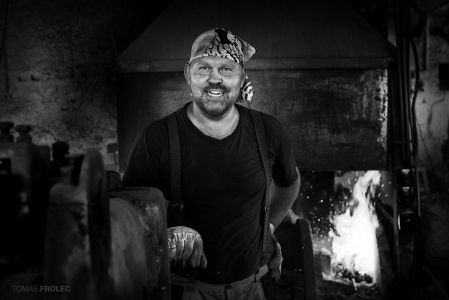Hardening, tempering.....observations of the process of making a Gassan style katana
Yesterday (12/08/2022) I finished the hardening part of the forging of the Gassan school sword. It's a bit of a different job from other styles of swords. I used shingane steel almost identical to kawagane (blade sides) to compose the final Hon san mai package. But with a marginal carbon content for hardening (about 0.5%) The bar is about 3mm wider at the kassane (11mm) when drawn to the required length compared to the commonly produced blades (8-9mm). The reason for the two differences is the formation of the ayasugi hada. In this case, I used the wave forming forging method. By pushing two round surfaces against each other, a dent about 1.5mm deep is formed in the rod on both sides. This, after flattening the surface of the bar by grinding it flat to a final 8mm thickness, forms the structure of the steel into a pattern of waves or circles. This process results in a change in the density of the steel in the extruded areas. This may be reflected in the final hamon line shape when hardened.
A typical hamon for the Gassan school is the suguha. My intention was to create a suguha with a broader line of nioi and with moderate activities that would distort the suguha hamon a little. I used a paste of clay (kaolin) and water glass to create the suguha pattern. I noticed that the technique of applying clay is considered very important in Japan. I'm not sure about this sometimes exaggerated approach. Perhaps I am influenced by my favourite and often used Ichimonji style, in which clay is hardly used or only used as a supporting technique. I suspect that some Sōshu style swords were forged in a similar way, with a certain routine and common craftsmanship. The clay only served to support a certain natural pattern, and the hamon was not precisely defined by precise paste coding.
In suguha, the height of the hamon is of course determined by the application of the paste. By raising the temperature a little and staying on it while heating the blade before plunging it into the water, the hamon height under the clay can increase slightly, due to the formation of a coarser and wider crystalline structure of the Nioi line. However, care must be taken. If there is about 0.7%C or more in the steel, then it is highly susceptible to cracking (hagire). This is also due to the tendency of blades with higher C content to bend more when hardened. At a C content of 0.6%, it is considerably more resistant. My blade had a C content somewhere between 0.6-0.7%C. Therefore, bending it to a higher temperature and heating it longer was a risk. After plunging into water, the blade was significantly bent to about 3.5mm at the axis. I did not hear any cracking though. I immediately removed any residual clay and loosened the blade repeatedly. Tempering is necessary in such a case and as important for the blade properties as hardening. Hardening in water puts a lot of stress on the steel (even for the blacksmith :-))Before tempering, a lot of stress is built up in the blade. Hamon is very hard (62-64). If you don't loosen the blade, it can crack for no apparent reason. It's like a bow permanently stretched to the limit. In use, all it takes is a little contact with an obstacle and the tension exceeds the limit that the steel can bear. Then the blade cracks or breaks. Heating to a temperature of about 250°C will reduce the tension. The bending of the blade after hardening was large, therefore the shudder in the steel was large. Therefore, I repeated the tempering to about 250°C 4 times. The blade deflection decreased by about 0.5 cm during this process. It also reduced the hardness of the hamon. This is important. A hamon hardness of 60-62 is quite sufficient. Very hard hamon is blue in colour. After polishing, it looks like ice or glass. It's very susceptible to breakage. If the blade is heated for a long time during hardening and is not tempered enough, the blade crumbles. Small particles of steel break out. Proper and sufficient tempering of the blade will change the blade properties from critical to optimum. Experience must be used.
The Gassan-style blade I clouded showed a different density of steel on the blade in an interesting way. This was caused by the formation of the ayasugi hada. The hamon edge sometimes tends to follow a wave pattern. In this case it is negligible, occasional and very slight suguha fluctuations. I have made tanto in the past where these changes have completely changed the hamon from suguha to something in the gunome style. It was very pronounced. Combined with Ayasugi, probably attractive as well.
You can see the whole process of making the blade , including the hardening process described, on my YouTube channel (katana making) after processing the video.
